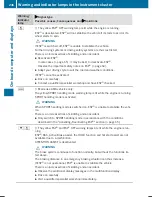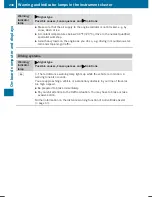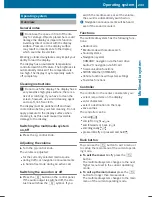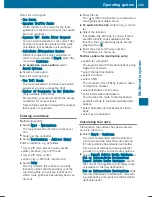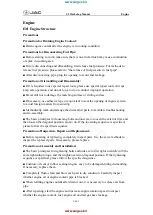
Loading guidelines
G
WARNING
If objects, luggage or loads are not secured
or not secured sufficiently, they could slip,
tip over or be flung around and thereby hit
vehicle occupants. There is a risk of injury,
particularly in the event of sudden braking
or a sudden change in direction.
Always store objects so that they cannot be
flung around. Secure objects, luggage or
loads against slipping or tipping before the
journey.
G
DANGER
Combustion engines emit poisonous
exhaust gases such as carbon monoxide.
Exhaust gases can enter the vehicle interior
if the tailgate is open while the engine is
running, especially if the vehicle is in
motion. There is a risk of poisoning.
Always switch off the engine before opening
the tailgate. Never drive with the tailgate
open.
G
WARNING
The exhaust tail pipe and tail pipe trim can
become very hot. If you come into contact
with these parts of the vehicle, you could
burn yourself. There is a risk of burns.
Always be particularly careful and supervise
children closely around the exhaust pipe and
the exhaust pipe trims. Allow these compo-
nents to cool down before touching them.
The handling characteristics of a laden vehicle
are dependent on the distribution of the load
within the vehicle.
Observe the following notes when loading and
transporting a load:
R
Never exceed the maximum permissible
gross vehicle mass or the gross axle weight
rating for the vehicle (including occupants).
The values are specified on the vehicle iden-
tification plate on the B-pillar of the driver's
door.
R
The cargo compartment is the preferred
place to carry objects.
R
Position heavy loads as far forward as possi-
ble and as low down in the cargo compart-
ment as possible.
R
The load must not protrude above the upper
edge of the seat backrests.
R
Always place the load against the rear or
front seat backrests. Make sure that the
seat backrests are securely locked into
place.
R
Always place the load behind unoccupied
seats if possible.
R
Use the cargo tie-down rings and the parcel
nets to transport loads and luggage.
R
Use cargo tie-down rings and fastening
materials appropriate for the weight and
size of the load.
R
The maximum load capacity of the stowage
well under the cargo compartment floor is
55 lbs (25 kg).
R
Secure the load with sufficiently strong and
wear-resistant tie-downs. Pad sharp edges
for protection.
!
Do not position the load on one part of the
folding cargo compartment floor only. The
maximum load capacity of the folding cargo
compartment floor is 220 lbs (100 kg). Dis-
tribute the weight evenly to avoid damaging
the cargo compartment floor. Place a solid
board under the load if necessary. Please
note that the load on the cargo compart-
ment floor will be increased when the load
is lashed down.
Stowage areas
Stowage spaces
Important safety notes
G
WARNING
If you transport objects in the vehicle inte-
rior and these are not adequately secured,
they could slip or be flung around and
thereby strike vehicle occupants. In addi-
tion, cup holders, open stowage spaces and
mobile phone brackets may not always be
250
Stowage areas
St
owage
and
feat
ur
es

